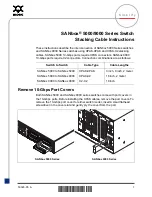
C
HAPTER
17
| Multicast Filtering
Layer 2 IGMP (Snooping and Query for IPv4)
– 619 –
N
OTE
:
Multicast routers use this information from IGMP snooping and query
reports, along with a multicast routing protocol such as DVMRP or PIM, to
support IP multicasting across the Internet.
P
ARAMETERS
These parameters are displayed:
◆
IGMP Snooping Status
– When enabled, the switch will monitor
network traffic to determine which hosts want to receive multicast
traffic. This is referred to as IGMP Snooping. (Default: Enabled)
When IGMP snooping is enabled globally, the per VLAN interface
settings for IGMP snooping take precedence (see
"Setting IGMP
Snooping Status per Interface" on page 626
).
When IGMP snooping is disabled globally, snooping can still be
configured per VLAN interface, but the interface settings will not take
effect until snooping is re-enabled globally.
◆
Proxy Reporting Status
– Enables IGMP Snooping with Proxy
Reporting. (Default: Disabled)
When proxy reporting is enabled with this command, the switch
performs “IGMP Snooping with Proxy Reporting” (as defined in DSL
Forum TR-101, April 2006), including last leave, and query
suppression.
Last leave sends out a proxy query when the last member leaves a
multicast group, and query suppression means that specific queries are
not forwarded from an upstream multicast router to hosts downstream
from this device.
When proxy reporting is disabled, all IGMP reports received by the
switch are forwarded natively to the upstream multicast routers.
◆
TCN Flood
– Enables flooding of multicast traffic if a spanning tree
topology change notification (TCN) occurs. (Default: Disabled)
When a spanning tree topology change occurs, the multicast
membership information learned by switch may be out of date. For
example, a host linked to one port before the topology change (TC)
may be moved to another port after the change. To ensure that
multicast data is delivered to all receivers, by default, a switch in a
VLAN (with IGMP snooping enabled) that receives a Bridge Protocol
Data Unit (BPDU) with TC bit set (by the root bridge) will enter into
“multicast flooding mode” for a period of time until the topology has
stabilized and the new locations of all multicast receivers are learned.
If a topology change notification (TCN) is received, and all the uplink
ports are subsequently deleted, a time out mechanism is used to delete
all of the currently learned multicast channels.
When a new uplink port starts up, the switch sends unsolicited reports
for all currently learned channels out the new uplink port.
By default, the switch immediately enters into “multicast flooding
mode” when a spanning tree topology change occurs. In this mode,
Summary of Contents for ECS3510-10PD
Page 1: ...Management Guide www edge core com 10 Port Layer 2 Fast Ethernet Switch...
Page 2: ......
Page 4: ......
Page 48: ...CONTENTS 48...
Page 68: ...SECTION I Getting Started 68...
Page 78: ...CHAPTER 1 Introduction System Defaults 78...
Page 96: ...CHAPTER 2 Initial Switch Configuration Managing System Files 96...
Page 98: ...SECTION II Web Configuration 98...
Page 118: ...CHAPTER 3 Using the Web Interface Navigating the Web Browser Interface 118...
Page 150: ...CHAPTER 4 Basic Management Tasks Resetting the System 150...
Page 196: ...CHAPTER 5 Interface Configuration VLAN Trunking 196 Figure 66 Configuring VLAN Trunking...
Page 238: ...CHAPTER 7 Address Table Settings Configuring MAC Address Mirroring 238...
Page 264: ...CHAPTER 8 Spanning Tree Algorithm Configuring Interface Settings for MSTP 264...
Page 274: ...CHAPTER 9 Congestion Control Automatic Traffic Control 274...
Page 288: ...CHAPTER 10 Class of Service Layer 3 4 Priority Settings 288...
Page 304: ...CHAPTER 11 Quality of Service Attaching a Policy Map to a Port 304...
Page 424: ...CHAPTER 13 Security Measures DHCP Snooping 424...
Page 568: ...CHAPTER 14 Basic Administration Protocols OAM Configuration 568...
Page 596: ...CHAPTER 15 IP Configuration Setting the Switch s IP Address IP Version 6 596...
Page 614: ...CHAPTER 1 IP Services Configuring the PPPoE Intermediate Agent 614...
Page 784: ...CHAPTER 20 System Management Commands Powered Device 784...
Page 814: ...CHAPTER 22 Remote Monitoring Commands 814...
Page 1008: ...CHAPTER 26 Interface Commands Power Savings 1008...
Page 1022: ...CHAPTER 27 Link Aggregation Commands Trunk Status Display Commands 1022...
Page 1052: ...CHAPTER 29 Congestion Control Commands Automatic Traffic Control Commands 1052...
Page 1064: ...CHAPTER 31 UniDirectional Link Detection Commands 1064...
Page 1070: ...CHAPTER 32 Address Table Commands 1070...
Page 1130: ...CHAPTER 34 ERPS Commands 1130...
Page 1172: ...CHAPTER 35 VLAN Commands Configuring Voice VLANs 1172...
Page 1186: ...CHAPTER 36 Class of Service Commands Priority Commands Layer 3 and 4 1186...
Page 1302: ...CHAPTER 38 Multicast Filtering Commands MVR for IPv6 1302...
Page 1368: ...CHAPTER 40 CFM Commands Delay Measure Operations 1368...
Page 1390: ...CHAPTER 42 Domain Name Service Commands 1390...
Page 1448: ...CHAPTER 44 IP Interface Commands ND Snooping 1448...
Page 1450: ...SECTION IV Appendices 1450...
Page 1455: ...APPENDIX A Software Specifications Management Information Bases 1455 UDP MIB RFC 2013...
Page 1456: ...APPENDIX A Software Specifications Management Information Bases 1456...
Page 1482: ...COMMAND LIST 1482...
Page 1493: ......
















































